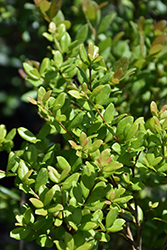It's all about ...
plants

Height: 8 feet
Spread: 10 feet
Sunlight:
![]()
Hardiness Zone: 10a
Description:
A medium to large evergreen shrub with a sturdy, short trunk and a conical to rounded crown; arching, slender branches feature small, fleshy, gray-green leaves at the ends; yellow, cup shaped flowers appear all year; great for dry, sandy, or coastal sites
Ornamental Features
Bay Cedar features dainty lightly-scented lemon yellow buttercup flowers at the ends of the branches from early winter to late fall. It has green evergreen foliage which emerges brick red in spring. The succulent narrow leaves remain green throughout the winter. The rough dark gray bark adds an interesting dimension to the landscape.
Landscape Attributes
Bay Cedar is a multi-stemmed evergreen shrub with an upright spreading habit of growth. Its average texture blends into the landscape, but can be balanced by one or two finer or coarser trees or shrubs for an effective composition.
This is a relatively low maintenance shrub, and can be pruned at anytime. It is a good choice for attracting birds, bees and butterflies to your yard. It has no significant negative characteristics.
Bay Cedar is recommended for the following landscape applications;
- Accent
- Mass Planting
- Hedges/Screening
- Rock/Alpine Gardens
- General Garden Use
- Naturalizing And Woodland Gardens
- Container Planting
Planting & Growing
Bay Cedar will grow to be about 8 feet tall at maturity, with a spread of 10 feet. It has a low canopy with a typical clearance of 1 foot from the ground, and is suitable for planting under power lines. It grows at a slow rate, and under ideal conditions can be expected to live for approximately 20 years.
This shrub should only be grown in full sunlight. It is very adaptable to both dry and moist growing conditions, but will not tolerate any standing water. It is considered to be drought-tolerant, and thus makes an ideal choice for xeriscaping or the moisture-conserving landscape. This plant should not require much in the way of fertilizing once established, although it may appreciate a shot of general-purpose fertilizer from time to time early in the growing season. It is not particular as to soil pH, but grows best in sandy soils, and is able to handle environmental salt. It is somewhat tolerant of urban pollution. This species is native to parts of North America. It can be propagated by cuttings.
Bay Cedar makes a fine choice for the outdoor landscape, but it is also well-suited for use in outdoor pots and containers. With its upright habit of growth, it is best suited for use as a 'thriller' in the 'spiller-thriller-filler' container combination; plant it near the center of the pot, surrounded by smaller plants and those that spill over the edges. It is even sizeable enough that it can be grown alone in a suitable container. Note that when grown in a container, it may not perform exactly as indicated on the tag - this is to be expected. Also note that when growing plants in outdoor containers and baskets, they may require more frequent waterings than they would in the yard or garden. Be aware that in our climate, most plants cannot be expected to survive the winter if left in containers outdoors, and this plant is no exception. Contact our experts for more information on how to protect it over the winter months.
This plant is not reliably hardy in our region, and certain restrictions may apply; contact the store for more information.
